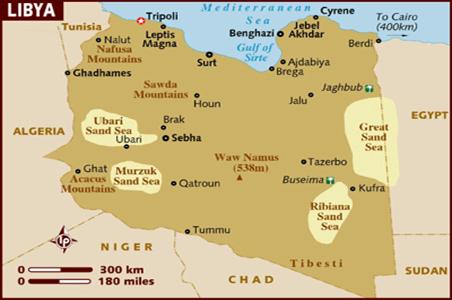NATO’s Destruction of Libya
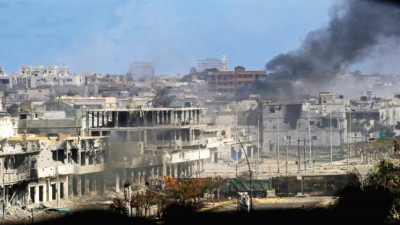
All Global Research articles can be read in 51 languages by activating the Translate Website button below the author’s name (desktop version)
To receive Global Research’s Daily Newsletter (selected articles), click here.
Follow us on Instagram and Twitter and subscribe to our Telegram Channel. Feel free to repost and share widely Global Research articles.
***
Robert Gates, the former US Secretary of Defense, wrote in his memoirs that when the decision was made to launch a military attack against Afghanistan in 2001, that nobody in Washington had a real idea of how complex a nation it is. This included Afghanistan’s various ethnic groups and the rivalries between urban and rural areas of the country.
It was a similar story with Iraq which the US, with heavy British support, invaded in the spring of 2003. Gates admitted “nearly always, we begin military engagements–wars–profoundly ignorant about our adversaries and about the situation on the ground” (1). Gates went on that the George W. Bush administration (2001–09) was unaware of how degraded Iraq was by 2003. The country, already poor, had suffered years of crushing financial measures imposed on it by the Western powers.
President Bush’s successor, Barack Obama (2009–17), was hardly more enlightened in relation to the north African state of Libya, which the US, alongside its NATO allies France and Britain, started bombing in March 2011.
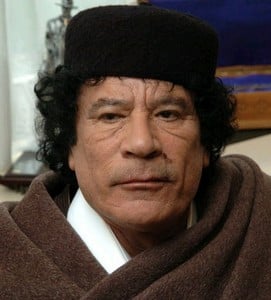 Libya’s rural structure is based on many tribal groups, for which blood and affinity were the main unifying force. When Muammar Gaddafi took power in Libya in 1969, he at first tried to reduce the significant influence of the nation’s tribes. Colonel Gaddafi believed it would be difficult to integrate them fully into the new, modern Libya which he planned to construct. He considered that tribalism weakened loyalty to the state, shifting power away from the government.
Libya’s rural structure is based on many tribal groups, for which blood and affinity were the main unifying force. When Muammar Gaddafi took power in Libya in 1969, he at first tried to reduce the significant influence of the nation’s tribes. Colonel Gaddafi believed it would be difficult to integrate them fully into the new, modern Libya which he planned to construct. He considered that tribalism weakened loyalty to the state, shifting power away from the government.
Gaddafi had grown up in a semi-nomadic Bedouin tribe in northern Libya. He understood the tribal life and mentality. With Gaddafi’s attempt to negate the power of the indigenous communities, he divided Libya into zones that split the tribal borders. His policy separated certain tribes and merged them with others into a common zone.
Yet Gaddafi was unable to completely subdue the tribal authority. Out of Libya’s more than 140 tribes, between 30 to 40 of them possessed varying degrees of political sway (2). Recognising it would be dangerous to alienate the indigenous people, Gaddafi pragmatically negotiated alliances with them. In this way he won a certain amount of loyalty from the tribes, or at least neutrality, in which the clan chiefs did not pose a threat to Gaddafi’s leadership or to his government in Tripoli, the capital city.
Libya is among Africa’s biggest countries and it shares a lengthy coastline with the Mediterranean Sea. It was only Gaddafi who had managed to hold together Libya and its fragile national structure, since the state’s independence in the early 1950s. Under Gaddafi, though the country was not a paradise, Libya enjoyed by some distance the best living standards in Africa. By 2010, the year before the NATO bombardment of Libya began, a UN Human Development report placed Libya at the top end of the high human development bracket (3). With regards to living conditions, Libya was ranked 53rd out of more than 190 countries in the human development table.
In 2010 living standards in Libya – based on life expectancy, annual income, etc. – were superior in comparison to major countries like Brazil, China and India. Standard of living in Gaddafi’s Libya was also better than people were experiencing in places like Bulgaria, the Ukraine, Macedonia and Albania.
In mid-January 2011, armed protests against Gaddafi’s government occurred in the Libyan cities of Benghazi, Derna and Bayda. These were not peaceful demonstrations and resulted in dozens of deaths. Many of the insurgents had been encouraged by Anglo-French special forces. The rebels were also advised to secure control over Libya’s oil installations, located in the northern parts of the nation.
It was in early 2011 that the second-in-command of the extremist organisation Al Qaeda, Ayman al-Zawahiri, sent veteran terrorists to Libya so as to establish a foothold in the country (4). Western news agencies, and television networks, were portraying the anti-Gaddafi insurgents as benign civilians, despite the fact that video clips showed the “moderates” walking around heavily armed. Intelligence amassed by the CIA, however, stated that the opposition by themselves did not have enough strength to overthrow Gaddafi. That could be done only with outside interference which was well under way.
Elite soldiers from a NATO and EU state, the Netherlands, belonging to the Korps Commandotroepen (KCT), were taken prisoner by Gaddafi’s troops in Sirte, on the southern shore of the Gulf of Sidra, at the end of February 2011. These special forces from the Royal Netherlands Army entered Libya by helicopter (5). On 24 February, a British vessel called ‘HMS Cumberland’ had arrived into the port of Libya’s second largest city, Benghazi, and British Special Air Service (SAS) commandos walked off the ship. In the weeks before the March 2011 NATO bombing had commenced, special forces from the US, France and Britain were present on Libyan soil; among them were CIA personnel, MI6 officers and French secret agents.
The Italian journalist, Franco Bechis, wrote that France’s foreign intelligence agency (DGSE) had been planning the revolt in Libya since the autumn of 2010 (6). One of Gaddafi’s close colleagues, the Chief of Protocol Nuri al-Mismari, who had fallen out with his leader, abandoned Libya in October 2010 and, by way of Tunisia, he moved on to France. In Paris, al-Mismari spoke at length to the French authorities about the situation in Libya, and he also met with the French military. The plot against Gaddafi involved opposition figures in Benghazi. On 23 December 2010 three Libyan insurgents arrived in Paris, named Ali Ounes Mansouri, Farj Charrant and Fathi Boukhris – they would help to organise the effort to topple Gaddafi, along with France’s military and al-Mismari.
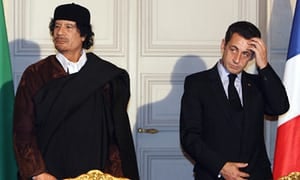 The French leadership and its president at the time, Nicolas Sarkozy (2007–12), wanted to oust Gaddafi for various reasons. Gaddafi was showing too much independence and unpredictability for the West’s liking. In 2009 the Libyan leader had compelled the French energy multinational, Total, to accept inferior terms relating to oil and gas deals from Libya (7). Total’s contract for the exploitation of oil fields with Libya’s state-owned firm, the National Oil Corporation (NOC), was considerably reduced. Moreover, the French had to accept lower terms (30%) from Libya’s gas production rate, whereas with previous contracts they had taken 50%. (8)
The French leadership and its president at the time, Nicolas Sarkozy (2007–12), wanted to oust Gaddafi for various reasons. Gaddafi was showing too much independence and unpredictability for the West’s liking. In 2009 the Libyan leader had compelled the French energy multinational, Total, to accept inferior terms relating to oil and gas deals from Libya (7). Total’s contract for the exploitation of oil fields with Libya’s state-owned firm, the National Oil Corporation (NOC), was considerably reduced. Moreover, the French had to accept lower terms (30%) from Libya’s gas production rate, whereas with previous contracts they had taken 50%. (8)
It was the case that the American fossil fuel corporations, Chevron and Occidental Petroleum, were forced by Gaddafi’s government to accept lesser deals from Libya in 2009. Libya contains the largest oil reserves in Africa and the quality of its petroleum is very good. The British had investments too in Libya, worth £1.5 billion, mainly in the oil industry (9). Even before Gaddafi’s demise Lord Stephen Green, the British Minister for Trade and Investment, travelled to Tripoli in late September 2011 at the head of a delegation of businessmen, including officials from British Petroleum (BP) and Shell. They were in Libya to have talks concerning business deals with the National Transitional Council, the new de facto government of Libya.
A report from the Guardian newspaper on 26 September 2011 noted,
“British companies are not alone in seeking to make money in post-Gaddafi Libya… The best hotels in Tripoli and Benghazi are buzzing with visiting businessmen as well as security consultants, diplomats, and journalists”. (10)
It may be worth pointing out that the terrorist organisation, the Libyan Islamic Fighting Group (LIFG), had performed a central role in the insurgency against Gaddafi. The LIFG commander was Abu Yahya al-Libi, a top-ranking member of Al Qaeda. As with al-Libi, the Al Qaeda boss, Osama bin Laden, was firmly backing the rebellion in Libya and also in Syria.
At the start of April 2011, Bin Laden outlined his desire to see Gaddafi gone and he described the unrest as “a great and glorious event” (11). In a message of 28 March 2011, Bin Laden wrote that he was proud of the response of his “Libyan brothers” who joined the revolt in the country, and that more Al Qaeda fighters were then entering Libya, while others were being prepared to train in neighbouring Algeria.
As was the case in Syria the Western powers and the extremist groups, though for differing reasons, wanted the same immediate outcome: the removal of Gaddafi and Syrian president Bashar al-Assad.
In late February 2011 Sarkozy, as though he was the ruler of Libya, said at a news conference, “Mr Gaddafi must leave” (12). In mid-March, president Obama echoed his French counterpart, “Mr Gaddafi has lost legitimacy and he needs to leave”, a view which was shared by Jose Manuel Barroso, the European Commission president. (13)
Obama was being regularly encouraged by his Secretary of State, Hillary Clinton, to intervene militarily in Libya. On 26 February 2011, the White House accused Gaddafi of “continued violation of human rights and brutalization of its people” (14). This opinion was reiterated by German leader Angela Merkel, who 8 years before had supported the US-led invasion of Iraq. Obama and Merkel neglected to mention that Libya, as noted earlier, enjoyed the best living conditions in Africa, with the highest life expectancy on the continent.
Shortly before the attack on Libya, when the West proposed to the UN Security Council a no-fly zone over Libya, their politicians failed to provide evidence that Gaddafi was using military aircraft against protesters. Proof could not be found and so nothing justified the establishment of a no-fly zone, or a NATO intervention. It was a pretext to allow the West to assail Libya from the air and to replace Gaddafi. On 30 June 2011 Gaddafi’s son, Saif al-Islam Gaddafi, said in an interview that one of Libya’s major errors had been to delay the purchase of weaponry from Russia. (15)
NATO was providing material aid to extremist groups in Libya, such as the LIFG (16). Five months into the assault, a NATO vessel sailed into the Libyan shoreline loaded down with weapons. Emerging from the ship were soldiers from the US Joint Special Operations Command (JSOC), SAS commandos and units from the French Army Special Forces Command (BFST). These groups had formulated a plan for the capture of Tripoli, and the city would subsequently fall on 28 August 2011. Now that Tripoli had been lost, the end was not far away for Gaddafi. With crucial NATO support, he would be killed less than two months later in Sirte, to the east of Tripoli.
Following NATO’s “humanitarian intervention” in Libya, at the end of 2011 the country’s UN human development ranking had already fallen 11 places to 64th. By 2019, Libya’s position had plummeted to 110th position (17). From the final year of Gaddafi’s reign, this is one of the steepest drops recorded for any nation relating to living standards. After Gaddafi’s ousting, Libya became a broken country fought over by rival factions. The state had lost the power to govern.
*
Note to readers: Please click the share buttons above. Follow us on Instagram and Twitter and subscribe to our Telegram Channel. Feel free to repost and share widely Global Research articles.
This article was originally published on Geopolitica.RU.
Shane Quinn obtained an honors journalism degree. He is interested in writing primarily on foreign affairs, having been inspired by authors like Noam Chomsky.
He is a Research Associate of the Centre for Research on Globalization (CRG).
Notes
1 Robert M. Gates, Duty: Memoirs of a Secretary at War (WH Allen, 6 August 2015) End Chapter, Reflections
2 Luiz Alberto Moniz Bandeira, The World Disorder: US Hegemony, Proxy Wars, Terrorism and Humanitarian Catastrophes (Springer; 1st edition, 4 February 2019) p. 100
3 Human Development Report 2010, 20th Anniversary Edition, p. 158 of 238
4 Luiz Alberto Moniz Bandeira, The Second Cold War: Geopolitics and the Strategic Dimensions of the USA (Springer 1st edition, 23 June 2017) p. 161
5 Ibid., p. 176
6 Franco Bechis, “France had been preparing to overthrow Gaddafi since November [2010]”, Voltairenet.org, 25 March 2011
7 Bandeira, The Second Cold War, p. 172
8 Ibid.
9 “British trade mission seeks to make most of Libyan goodwill”, The Guardian, 26 September 2011
10 Ibid.
11 Bandeira, The Second Cold War, p. 161
12 “France’s Sarkozy says Gaddafi must go”, Reuters, 25 February 2011
13 “Libya: US and EU say Muammar Gaddafi must go”, BBC, 11 March 2011
14 “Readout of President Obama’s Call with Chancellor Angela Merkel of Germany”, 26 February 2011
15 Bandeira, The Second Cold War, p. 171
16 Ibid., p. 160
17 Human Development Report 2019, p. 315 of 366
Featured image is from Geopolitica.RU
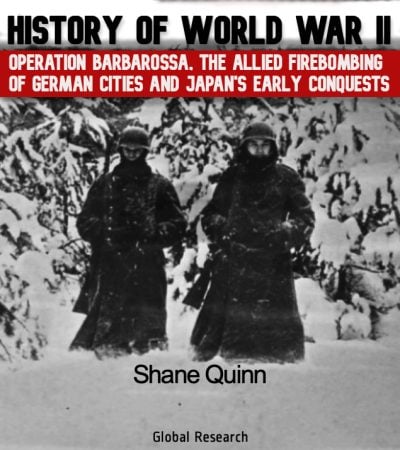 History of World War II: Operation Barbarossa, the Allied Firebombing of German Cities and Japan’s Early Conquests
History of World War II: Operation Barbarossa, the Allied Firebombing of German Cities and Japan’s Early Conquests
By Shane Quinn
The first two chapters focus on German preparations as they geared up to launch their 1941 invasion of the Soviet Union, called Operation Barbarossa, which began eight decades ago. It was named after King Frederick Barbarossa, a Prussian emperor who in the 12th century had waged war against the Slavic peoples. Analysed also in the opening two chapters are the Soviet Union’s preparations for a conflict with Nazi Germany.
The remaining chapters focus for the large part on the fighting itself, as the Nazis and their Axis allies, the Romanians and Finns at first, swarmed across Soviet frontiers in the early hours of 22 June 1941. The German-led invasion of the USSR was the largest military offensive in history, consisting of almost four million invading troops. Its outcome would decide whether the post-World War II landscape comprised of an American-German dominated globe, or an American-Soviet dominated globe. The Nazi-Soviet war was, as a consequence, a crucial event in modern history and its result was felt for decades afterward and, indeed, to the present day.
Click here to read the e-book.


